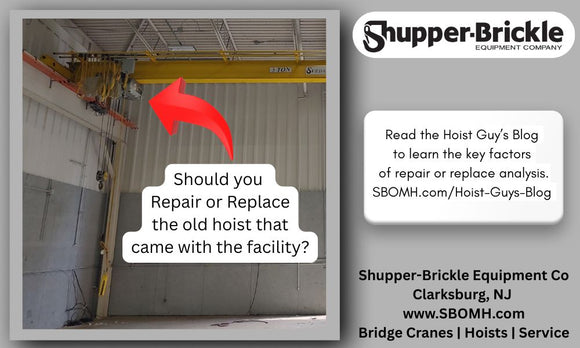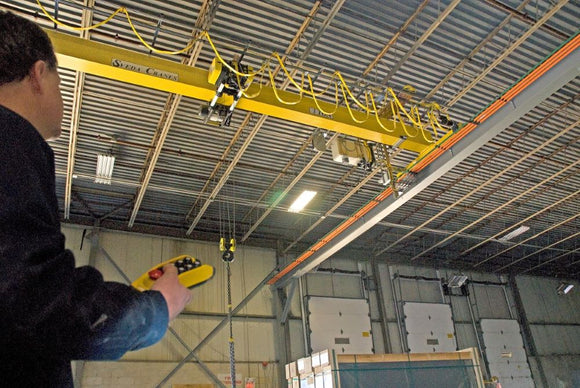
Custom Clean Room Hoists to Accommodate Special Space Limitations
Andrew T. Litecky
Welcome to The Hoist Guy's Blog, where our resident hoist guy, Andrew T. Litecky, shares his industry knowledge and experience with custom engineered solutions. In this case study, we’ll walk you through how we solved an overhead lifting challenge for a clean room application with significant space limitations.
Case Study: Four Maintenance Hoists for a Clean Room with Space Limitations
Shupper-Brickle Equipment was asked to come up with a custom lifting solution for an application that called for four maintenance hoists in a clean room with special space limitations.
The Spacing Challenges of the Clean Room
This overhead lifting system was for a clean room that had a few different space challenges. The first was that the distance from the end of the hoist bumper to the true vertical lift center of the hook block could only measure 24” to make a critical pick. Further, ceiling obstructions limited the hoist’s width and prevented the use of standard hoist-mounted controls. Shupper-Brickle customized work-arounds and alternatives to meet this specification.

Special Features of the Overhead Lifting System
The experienced engineering team at Shupper-Brickle customized work-arounds and alternatives to meet not only the space limitations of this specification but also accommodate the clean room requirements.
- To achieve the pick with a very limited end approach, the system used a two -wheel idler trolley with a safety drop lug on the inside of the frame. With this method, the trolley only measured about 24” from the stop to the centerline of the hook, compared with a typical design of 32.”
- A standard hoist motor would have interfered with obstructions in the ceiling. Therefore, the hoist profile was narrowed by using a “pancake motor,” so its overall dimensions were more wide than long. By making this change, about 8” were gained.
- Overload devices are mounted horizontally to maximize high hook dimension.
- Equalizer diaphragm breathers allow the hoist gearcase and trolley gearcase to breathe during operation. When the hoist and trolley are in use, the gear case oil particulates are captured in the sealed flexible diaphragm to prevent contamination of the cleanroom.
- All moving parts are stainless steel, including the wire rope, the drum, the sheaves, the hook block, the trolley wheels and guards for the geared wheels, the drum pockets and the overload device.
- The finish on the nonmoving hoist parts is “Steel-It,” a polyurethane coating with a high pigment with 316 stainless steel flakes mixed in. It is durable, resisting chipping and wear. It is a well-suited finish for a clean room and a tremendous cost savings over a completely stainless steel hoist.
- Stainless steel web mounted brackets were used for the festooning. Typical festooning brackets run on the top of the beam, but in a clean room the beam’s top flange is frequently embedded into the ceiling. Therefore, the festooning mounting was customized with web mounted cross arm brackets that carry the electrification system.
- Remotely mounted controls are important because there wasn’t enough room in the ceiling to mount the controls on the hoist. The low profile junction box on the hoist is then connected to the main control box. This creates a very good maintenance tool, since the junction box can be serviced at ground level, instead of at the beam’s height. Because the system is controlled by a wireless radio remote, an amber beacon light flashes when power is put to the system, as required by ANSI.
Why Choose Shupper-Brickle for Your Custom Hoist Engineering?
With over 50 years of hoist and crane experience and a full-service engineering department, We make it easy by:
- Assembling the best manufactured products for the system. It this case, that was – Electrolift wire rope hoists and Duct-o-wire stainless steel festooning.
- Pre-wiring the festooned flat wire to the monorail mounted junction box: Flat wire is connected by a field electrician to the hoist mounted junction box. All wires are marked to match the number on the terminal in the terminal strip of the monorail mounted junction box. This saves time for the customer installing the system, because they only need to connect the flat wire conductors as shown on the photos.
- Performing electrical & functional testing to confirm continuity and motions (up/down, forward/reverse) as well as testing safety features like limit switches. All FAT’s (factory acceptance tests) are documented for the record. This confirms that all features perform as expected before the installation of the hoist.
- Step by step installation instructions are provided for the contractor performing installation of the overhead lifting system, and Shupper-Brickle is available for phone and virtual meeting consultations.
Custom Engineering for Clean Room Applications
Shupper-Brickle Equipment has provided the best value in overhead lifting equipment, comprehensive services and custom engineering since 1969 with extensive experience providing equipment for clean environments. We have a specialized selection of hoists and cranes to meet the demanding needs of pharmaceutical and cleanroom overhead material handling applications, offering both factory-standard equipment as well as custom-engineered systems. Contact us for a custom solution to your clean room needs including a complete analysis and custom design of an overhead material handling system.


